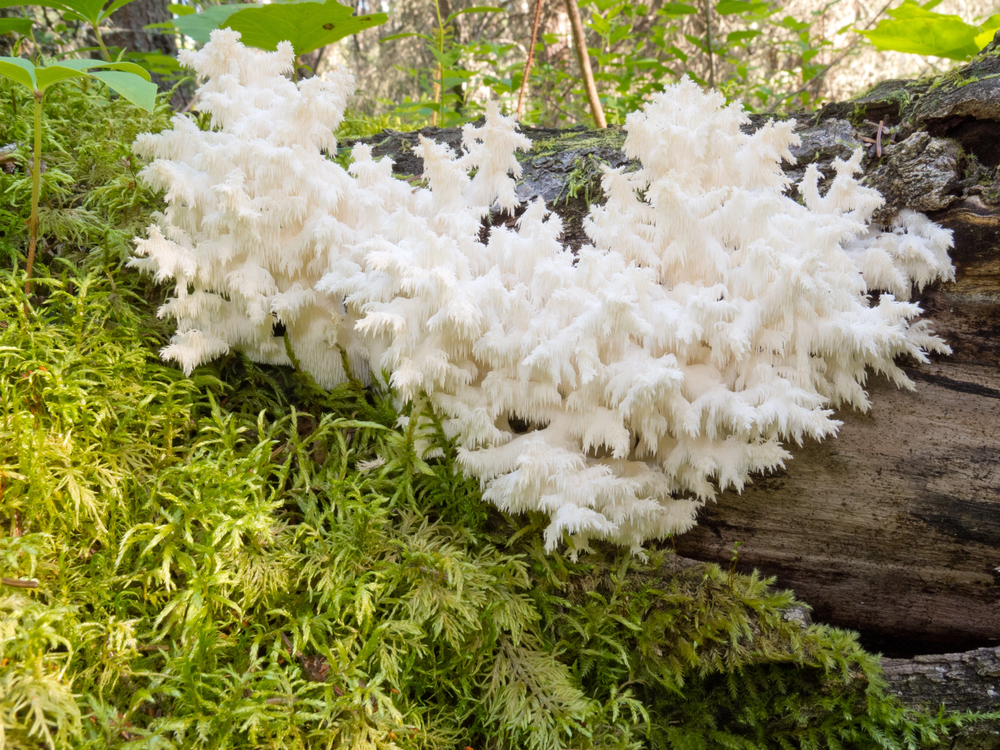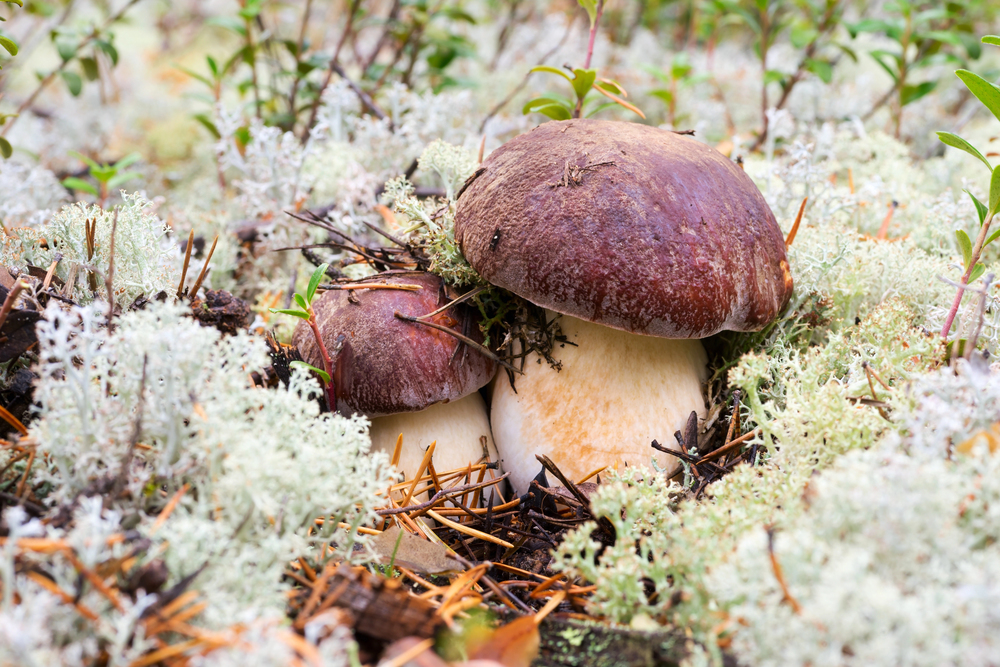In mycology, the resemblance of certain mushrooms to chanterelles like Omphalotus olearius and Hygrophoropsis aurantiaca can lead to dangerous misidentifications.
It is important for foragers to differentiate between these toxic lookalikes and true chanterelles to avoid severe consequences.
Accurate identification methods are essential for a safe foraging experience and to fully enjoy the culinary treasures of the wild.
Jack-O-Lantern Mushroom (Omphalotus Olearius)
Omphalotus olearius, also known as the Jack-O’-Lantern mushroom, can be confused with chanterelles because of their similar appearance. However, it is important to distinguish between the two as Omphalotus olearius is toxic, whereas chanterelles are safe to consume.
Characteristics like the mushroom’s gills and spore print can aid in distinguishing between these two species.
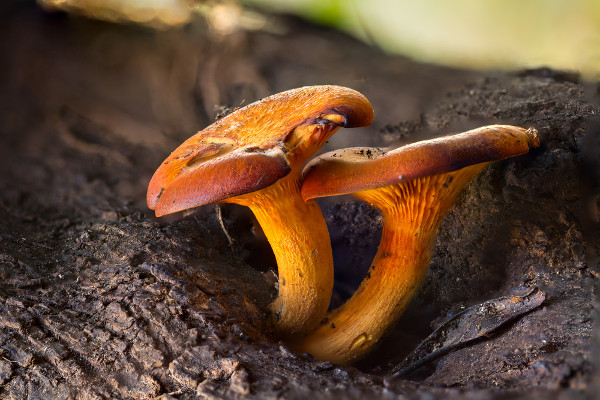
Toxicity of Omphalotus Olearius
Ingesting Omphalotus olearius mushrooms can lead to severe toxicity symptoms in humans due to toxins like illudins. Symptoms may include gastrointestinal distress such as nausea, vomiting, and diarrhea, with potential for liver damage or failure in severe cases.
These toxins are not eliminated by cooking, so consuming cooked mushrooms still poses a risk. It is strongly advised to avoid consuming Omphalotus olearius mushrooms, despite their resemblance to edible chanterelles.
In case of accidental ingestion, immediate medical attention is recommended to manage and treat toxicity symptoms effectively.
| Toxicity Level | Symptoms | Treatment |
|---|---|---|
| High | Vomiting, Diarrhea, Cramps | Seek medical help |
Identification Tips for Jack-O-Lantern
When foraging for mushrooms, it’s important to know how to identify Omphalotus olearius, also known as Jack o’ lantern mushrooms, to avoid mistaking them for edible chanterelles.
Omphalotus mushrooms have true gills, emit a faint green glow in low light, and produce bitter orange latex when cut. These features help differentiate them from look-alike species and prevent accidental ingestion of the toxic Omphalotus mushrooms.
False Chanterelle (Hygrophoropsis Aurantiaca)
False chanterelle lookalikes, such as the toxic Jack-o’-Lantern mushroom, closely resemble true chanterelles but can be distinguished by their gills underneath the cap (compared to the false gills of chanterelles), different spore print color, and lack of fruity aroma.
Foragers must carefully examine mushrooms to avoid consuming the toxic lookalikes found in similar habitats to chanterelles. Learning to differentiate between these species is essential for safe foraging practices and to prevent potential health risks from poisonous mushrooms.
False chanterelle is a vibrant orange mushroom with distinctive gills. It can be found in coniferous and deciduous forests in Europe and North America. The cap is convex, orange, and slightly velvety, while the decurrent gills run down the stem and may fork near the base.
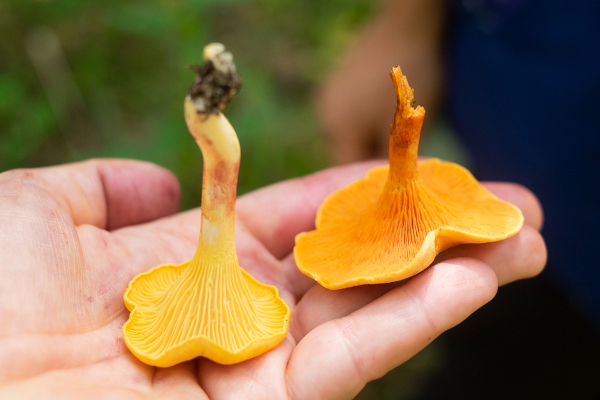
Unlike chanterelles, it lacks a fruity aroma. Not recommended for consumption due to causing gastrointestinal upset in some people, proper identification is important to avoid health risks. Consult with a mycologist or use field guides for safe foraging.
Other Cantharellus Impostors
Golden Scalycap
The Golden Scalycap mushroom, scientifically known as Pholiota aurivella, closely resembles true chanterelles with its golden to orange cap and textured appearance from scales or fibers.
Found in clusters on decaying wood, especially conifer stumps or logs, they have a convex cap that flattens with age and gills initially covered by a veil that forms a ring on the stem.
While visually similar to chanterelles, Golden Scalycaps are not as prized for culinary purposes.
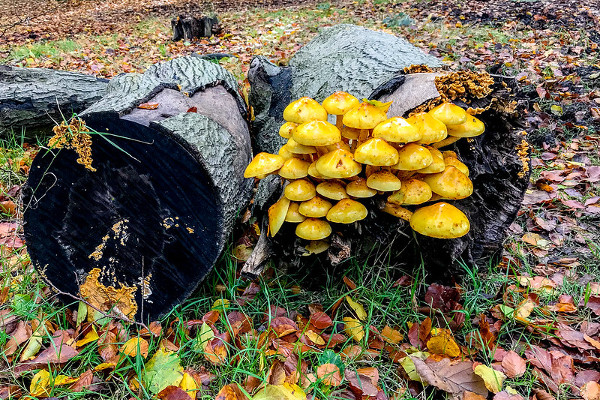
Gomphus Clavatus Varieties
The Gomphus Clavatus varieties, also known as pig’s ears or violet chanterelles, stand out for their trumpet-shaped purple caps. These mushrooms prefer coniferous forests and shady, humid environments.
While resembling chanterelles, they have a distinct funnel-like shape and darker hue, making cautious identification crucial due to potential toxicity.
Yellow Foot Mushroom Mimics
In mycology, distinguishing yellowfoot mushroom mimics from genuine Craterellus tubaeformis is a challenging task. Yellowfoot mushrooms are prized for their delicate flavor and unique appearance, but several similar-looking species exist in nature, requiring foragers to develop a keen eye to avoid misidentification.
To differentiate mimics from true Craterellus tubaeformis, consider these key characteristics:
- Cap Shape: Yellow Foot Mushrooms have a funnel-shaped cap, while mimics may have a more convex or irregular shape.
- Coloration: True Yellow Foot Mushrooms display a vibrant yellow-orange color on both the cap and stem, while imposters may vary in color or lack this distinct hue.
- Texture: Pay attention to the smooth and slightly slimy surface of the cap and stem of Yellow Foot Mushrooms, which can help in distinguishing them from look-alikes.
Black Trumpet
The black trumpet mushroom, scientifically known as Craterellus Cornucopioides, is a prized culinary delicacy sought after for its rich, smoky flavor with earthy undertones and a unique aroma reminiscent of black truffles. This trumpet-shaped mushroom species grows in a funnel-like shape with dark brown to black fruiting bodies.
It can be found in deciduous and coniferous forests across North America, Europe, and Asia, thriving in humid, shady environments near oak, beech, and pine trees. Despite its dark coloration, it can be challenging to spot due to its camouflaging effect among leaf litter and forest debris.
In dishes like risottos, pastas, sauces, and soups, the black trumpet adds an intense flavor that enhances the overall taste profile, making it a sought-after ingredient for culinary enthusiasts.
Smooth Chanterelle Imposters
False chanterelles, also known as smooth Chanterelle imposters, closely resemble true chanterelles but can be differentiated by key features:
- Cap Texture: False chanterelles have a smooth cap surface, unlike the ridged or wrinkled cap of true chanterelles.
- Gill Attachment: True chanterelles typically have gills running down the stem, while false chanterelles may have more decurrent or sinuate gills.
- Spore Print Color: True chanterelles produce a white to pale yellow spore print, whereas false chanterelles may have a different color like pale pink or brownish.


